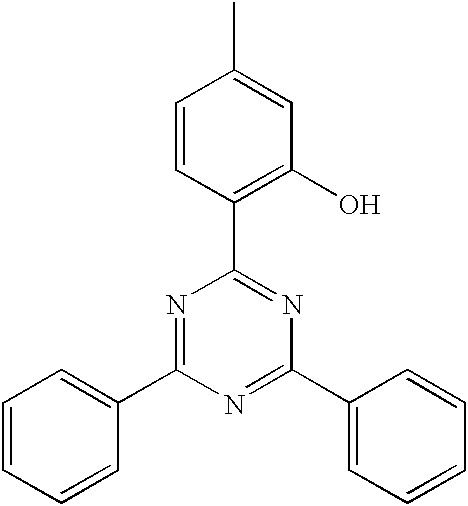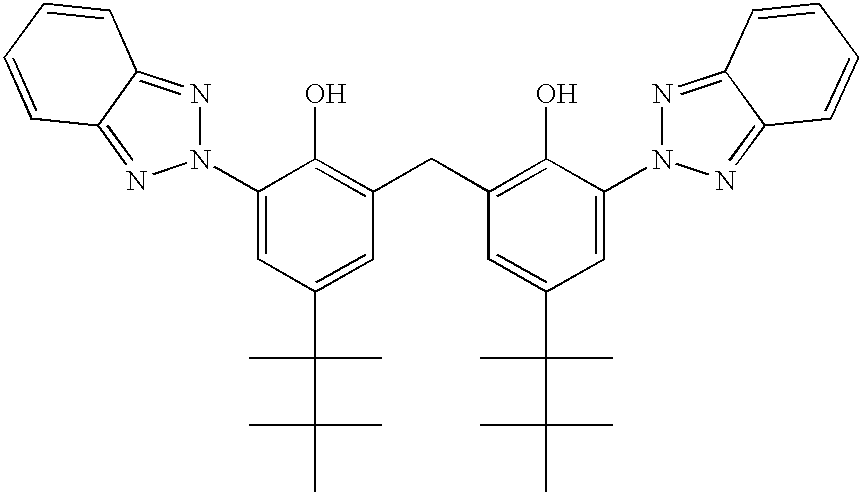Transparent, UV resistant, thermoformable film made from crystallizable thermoplastics, its use and process for its production
a technology of thermoformable film and crystallization thermoplastic, which is applied in the direction of signs, applications, construction elements, etc., can solve the problems of film and molding, yellowing of films and moldings, and impairment of mechanical properties, and propose the way to improve the uv resistance of films of this typ
- Summary
- Abstract
- Description
- Claims
- Application Information
AI Technical Summary
Benefits of technology
Problems solved by technology
Method used
Image
Examples
example 1
[0092]A transparent film of 50 μm thickness is produced, comprising polyethylene terephthalate as principal constituent, 0.3% by weight of Sylobloc, and 1.0% by weight of the UV stabilizer 2-(4,6-diphenyl-1,3,5-triazin-2-yl)-5-(hexyl)oxyphenol (®Tinuvin 1577 from Ciba-Geigy).
[0093]Tinuvin 1577 has a melting point of 149° C. and is thermally stable up to about 330° C.
[0094]To obtain homogeneous distribution, 0.3% by weight of Sylobloc and 1.0% by weight of the UV stabilizer are incorporated directly into the polyethylene terephthalate at the premises of the producer of the raw material.
[0095]The polyethylene terephthalate from which the transparent film is produced has a standard viscosity SV (DCA) of 810, corresponding to an intrinsic viscosity IV (DCA) of 0.658 dl / g, and has a DEG content of 1.6% by weight and a PEG content of 1.7% by weight.
[0096]The 50 μm monofilm is produced by the extrusion process described.
[0097]The transparent PET film produced has the following property pro...
example 2
[0101]Using a method based on Example 1, a transparent film is produced, the UV stabilizer 2-(4,6-diphenyl-1,3,5-triazin-2-yl)-5-(hexyl)oxyphenol (®Tinuvin 1577) being added in the form of a masterbatch. The masterbatch is composed of 5% by weight of ®Tinuvin 1577 as active component and 95% by weight of the polyethylene terephthalate from Example 1.
[0102]Prior to extrusion, 90% by weight of the polyethylene terephthalate from Example 1 are dried with 10% by weight of the masterbatch for 5 hours at 170° C. Extrusion and film production take place by a method based on Example 1.
[0103]The transparent PET film produced has the following property profile:
[0104]
Thickness50μmSurface gloss,Side 1160(Measurement angle 20°)Side 2157Light transmittance91.3%Haze3.8%Surface defectsnoneLongitudinal modulus of elasticity3600N / mm2Transverse modulus of elasticity4800N / mm2Longitudinal tensile stress110N / mm2at breakTransverse tensile stress at break190N / mm2Yellowness Index (YI)3.4
[0105]After 1000 hou...
example 3
[0107]Using a method based on Example 2, a transparent film of thickness 350 μm is produced. The PET film produced has the following property profile:
[0108]
Thickness350μmSurface gloss,Side 1149(Measurement angle 20°)Side 2144Light transmittance84.1%Haze13.1%Surface defects per m2noneYellowness Index4.5Longitudinal modulus of elasticity3100N / mm2Transverse modulus of elasticity3600N / mm2Longitudinal tensile stress at110N / mm2breakTransverse tensile stress at break190N / mm2
[0109]After 1000 hours of weathering per side using an Atlas Ci65 Weather-Ometer, the PET film has the following properties:
[0110]
Thickness350μmSurface gloss,Side 1136(Measurement angle 20°)Side 2131Light transmittance84.3%Haze14.0%Surface defects (cracks,noneembrittlement)Yellowness Index (YI)5.4Longitudinal modulus of elasticity3050N / mm2Transverse modulus of elasticity3500N / mm2Longitudinal tensile stress at100N / mm2breakTransverse tensile stress at break160N / mm2
PUM
| Property | Measurement | Unit |
|---|---|---|
| thickness | aaaaa | aaaaa |
| crystallite melting point | aaaaa | aaaaa |
| crystallization temperature | aaaaa | aaaaa |
Abstract
Description
Claims
Application Information
 Login to View More
Login to View More - R&D
- Intellectual Property
- Life Sciences
- Materials
- Tech Scout
- Unparalleled Data Quality
- Higher Quality Content
- 60% Fewer Hallucinations
Browse by: Latest US Patents, China's latest patents, Technical Efficacy Thesaurus, Application Domain, Technology Topic, Popular Technical Reports.
© 2025 PatSnap. All rights reserved.Legal|Privacy policy|Modern Slavery Act Transparency Statement|Sitemap|About US| Contact US: help@patsnap.com



